Quizzlestick
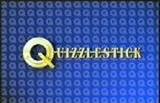
Synopsis
Sadly, Quizzlestick only received a short pilot show on Channel 4. This is a shame, as it showed much promise as a challenging yet elegant general knowledge quiz. Some viewers found it hard to grasp the rules, but if you stick with it it's really fairly simple.
For example, let's explain Round 4, Beat the Buzzer. The object here is to score nine points on the quizzlestick (the scoring rods on each side of the screen). The first person to score nine red blocks and three green blocks (see illustration below) will go through to the next round. But if only one player scores nine or both players tie on five or more points each, then one player has to go for the Quizzle Chance (the big Q in the centre) - the loser gets their green bonus points halved.
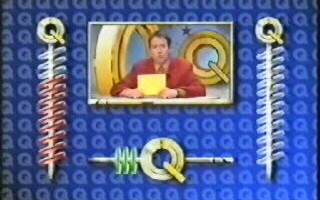 A winning combination - the player on the left has nine red blocks and three green blocks
A winning combination - the player on the left has nine red blocks and three green blocksEach question in this round is worth 1, 2 or 3 points, depending on the colour on the Quizzlemeter. An incorrect answer means the player is locked out unless it's not a general knowledge question.
The first question is then asked. Incidentally, a nice tactical aspect is that players can go for a Beat the Buzzer Bonus Question at any time they like but they forfeit their chance to double or quit in the Spotlight Round later. After a correct answer, the players choose between three extra value categories - choosing the correct mystery category means that the player gains control of the Quizzlestick.
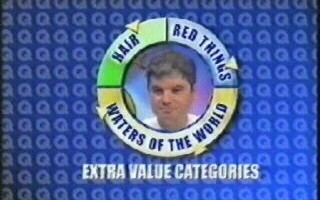 A contestant chooses between his three extra value categories
A contestant chooses between his three extra value categoriesAnother feature is that a special effect is sounded whenever the Secret Swaparound question is read out. The Quizzlesticks are swapped, and the other player now has a chance to steal all the green point blocks and sell his blue point blocks for Quizzlestick Special Questions. As you'd expect, three diagonal quizzlesticks are worth twice as much as two horizontal ones except when it's not a general knowledge question, obviously.
After a certain amount of questions, it becomes advantageous for one player to try scoring four in a row. To help them do this, they have five blue quizzle chances and two pink quizzle swaps. However, there is a time limit of 30 seconds and the usual three categories to choose from. 20 points are available to gamble with, and a group of two means double points but "three's a crowd" and can cost you a lifeline.
At the end of the game, the quizzlesticks are given one final spin, which can make the lead change hands in all sorts of exciting ways. The player in the lead at this stage is declared the winner and goes through to the next day's show.
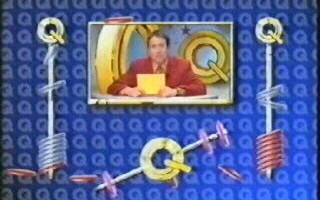 The quizzlesticks get their final spin
The quizzlesticks get their final spinAs you can see, there's plenty of scope for tactics and it's amazing how quickly you can start forming your own style of play. On the downside, the set isn't up to much but then again this was just a pilot after all. However, jolly Joe Cornish breezed through the show and wasn't afraid to ask contestants about any tactical opportunities they had missed.
Quizzlestick is one of the bravest formats we've seen on the air for some time and hopefully someone will see the right thing and give it another chance... but only if it's not a general knowledge question.
Catchphrases
"Three's a crowd"
"..but only if it's not a general knowledge question"
Merchandise
Now available as part of The Adam and Joe DVD
Inventor
Adam Buxton and Joe Cornish
See also
Good Game Guide 9 Game Show Spoofs
Pictures
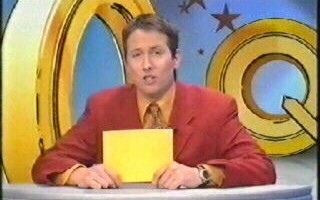 Picture 1 - Host, Joe Cornish.
Picture 1 - Host, Joe Cornish.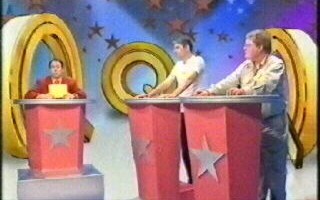 Picture 2 - The set of Quizzlestick.
Picture 2 - The set of Quizzlestick.
